#Industrial Area Nets
Text
The World's Forests Are Doing Much Better Than We Think
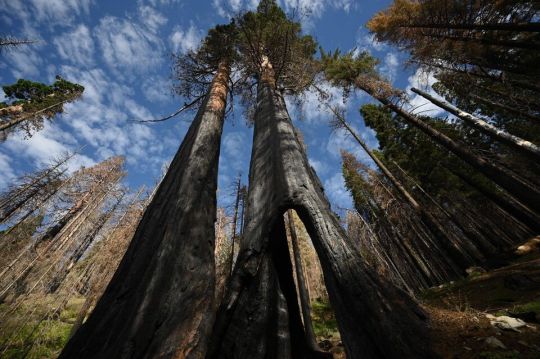
You might be surprised to discover... that many of the world’s woodlands are in a surprisingly good condition. The destruction of tropical forests gets so much (justified) attention that we’re at risk of missing how much progress we’re making in cooler climates.
That’s a mistake. The slow recovery of temperate and polar forests won’t be enough to offset global warming, without radical reductions in carbon emissions. Even so, it’s evidence that we’re capable of reversing the damage from the oldest form of human-induced climate change — and can do the same again.
Take England. Forest coverage now is greater than at any time since the Black Death nearly 700 years ago, with some 1.33 million hectares of the country covered in woodlands. The UK as a whole has nearly three times as much forest as it did at the start of the 20th century.
That’s not by a long way the most impressive performance. China’s forests have increased by about 607,000 square kilometers since 1992, a region the size of Ukraine. The European Union has added an area equivalent to Cambodia to its woodlands, while the US and India have together planted forests that would cover Bangladesh in an unbroken canopy of leaves.
Logging in the tropics means that the world as a whole is still losing trees. Brazil alone removed enough woodland since 1992 to counteract all the growth in China, the EU and US put together. Even so, the planet’s forests as a whole may no longer be contributing to the warming of the planet. On net, they probably sucked about 200 million metric tons of carbon dioxide from the atmosphere each year between 2011 and 2020, according to a 2021 study. The CO2 taken up by trees narrowly exceeded the amount released by deforestation. That’s a drop in the ocean next to the 53.8 billion tons of greenhouse gases emitted in 2022 — but it’s a sign that not every climate indicator is pointing toward doom...
More than a quarter of Japan is covered with planted forests that in many cases are so old they’re barely recognized as such. Forest cover reached its lowest extent during World War II, when trees were felled by the million to provide fuel for a resource-poor nation’s war machine. Akita prefecture in the north of Honshu island was so denuded in the early 19th century that it needed to import firewood. These days, its lush woodlands are a major draw for tourists.
It’s a similar picture in Scandinavia and Central Europe, where the spread of forests onto unproductive agricultural land, combined with the decline of wood-based industries and better management of remaining stands, has resulted in extensive regrowth since the mid-20th century. Forests cover about 15% of Denmark, compared to 2% to 3% at the start of the 19th century.
Even tropical deforestation has slowed drastically since the 1990s, possibly because the rise of plantation timber is cutting the need to clear primary forests. Still, political incentives to turn a blind eye to logging, combined with historically high prices for products grown and mined on cleared tropical woodlands such as soybeans, palm oil and nickel, mean that recent gains are fragile.
There’s no cause for complacency in any of this. The carbon benefits from forests aren’t sufficient to offset more than a sliver of our greenhouse pollution. The idea that they’ll be sufficient to cancel out gross emissions and get the world to net zero by the middle of this century depends on extraordinarily optimistic assumptions on both sides of the equation.
Still, we should celebrate our success in slowing a pattern of human deforestation that’s been going on for nearly 100,000 years. Nothing about the damage we do to our planet is inevitable. With effort, it may even be reversible.
-via Bloomburg, January 28, 2024
#deforestation#forest#woodland#tropical rainforest#trees#trees and forests#united states#china#india#denmark#eu#european union#uk#england#climate change#sustainability#logging#environment#ecology#conservation#ecosystem#greenhouse gasses#carbon emissions#climate crisis#climate action#good news#hope
3K notes
·
View notes
Text
https://aaradhyabalconysafetynets.com/
#children safety nets#terrace top safety nets#staircase safety nets#monkey safety nets#animal nets#coconut tree safety nets#industrial safety nets#construction safety nets#swimming pool safety nets#glass safety nets#car parking safety nets#parking nets#building safety nets#duct area safety nets#hdpe nets and nylon nets#pigeon safety nets#pigeon nets installation#bird spikes#bird protection nets#anti bird nets#pigeon nets for balcony#cricket nets#all sports nets#sports nets near me#football and volleyball nets#nursery shade nets#installation of nets#all safety nets#terrace nets#bird nets
0 notes
Text
Alive

Peter Parker x Male Reader
Warnings: Mentions of murder, kidnapping, brainwashing, child abuse. General violence, gun use, reader is a assassin, people get hurt…
Y/c/e = Your color eyes
Summary: Peter has to save Tony from a cold blooded assassin… + backstory stuff in the end…
(A/n: Reader is based on the character Widowmaker from Overwatch and the story is based on the Overwatch short ”Alive”.)
(A/n: Btw, Hi, It’s been a while)
——
Peter’s pov…
Peter entered the large convention center, it was filled with banners saying ”STARK” as well as new inventions on display. It still felt unreal that Tony Stark himself had personally invited him to such an event.
Lots of business and investors were in attendence to see what new tech ”Stark Industries” were bringing to the table, making Peter feel slightly out of place among them. He looked towards the big stage, where Tony and Pepper would soon be holding a speech regarding their future plans for Stark industries.
Peter looked around, the security seemed extra tight, which was understandable considering the combined net-worth of the people in the room could probably buy a planet.
Peter went along with the crowd gathered around the stage waiting for Tony Stark and Pepper Potts to come out. As soon as they did applause thundered through out the convention area.
Tony and Pepper stepped up to the podium and Tony Stark spoke up in the mic saying ”Welcome everyone…”
Your pov…
From the building across you looked down on the convention center with an icy glare. Then you jumped and fired your grappling hook and swung to the top of the convention center.
You snuck carefully in to the building and using your recon visor allowing you to locate the guards. You silently knocked out the guards on the top floor one by one. Then you found the perfect angle to set up and you brought out your rifle looking into the scope and searched for your target…
And then your crosshair landed on him, Tony Stark…
Peter’s pov…
As he watched Mr Stark speak Peter felt something, his spider senses told him that something was wrong. He looked around quickly but everything seemed fine. But his spider senses didn’t let up, Peter moved through the crowd towards the bathroom and sprinted inside.
He stripped out of his suit, revealing his Spider-suit underneath, he thought best to wear it since trouble is known to follow Tony Stark. He hid his clothes and started patrolling around. Then he saw it, on the top floor a sniper was aiming straight for Tony and was about to pull the trigger.
Peter quickly reacted swinging himself up to the sniper and he knocked the assassin to the side just as he pulled the trigger making the blast of the gunshot cut through the air. The gunshot had missed his target but alarmed Tony and the crowd. Peter looked as the sniper stood up and looked at him.

His visor had seven glowing red eyes and the visor shifted revealing your intense cold y/c/eyed stare. Peter said playfully ”Trying to crash the party” thinking he’d make easy work of the sniper. The sniper stood up as his rifle shifted. Peter’s spider sense suddenly flared up again and he dodged to the side as the assassin fired his rifle which had shifted from a sniper to an automatic rifle, firing quick shots his way.
Peter found cover and quickly had Karen cut in to the security guards communication channel. ”Mr Stark is in danger, shooter on the top floor, I repeat shooter on the top floor!”. A stern voice shouted back ”This is a secure channel, no one's a-”. Peter cut him off saying ”Tony Stark's in danger, get him out of here!” Peter commanded.
Peter then noticed the rifle shots had stopped he carefully peaked out and noticed that the assassin was nowhere to be seen, he carefully snuck out hiding towards the edge of the balcony floor to see that they were evacuating Mr Stark towards the exit.
Peter then caught a glimpse of something or rather someone outside on the roof top across from the convention center. Peter knew there was little time to he took a running start and rammed himself through one of the windows and swing to the other side of the street.
He landed a bit away from the shooter and as he ran closer to him, his spider-senses tingled once more but before he had time to dodge a hidden mine exploded setting free a gas that caused Peter to start coughing, he stumbled and fell and landed right before the assassin’s feet.
The attacker pressed Peter to the ground with his foot and aimed the sniper rifle right in his face, saying in a mocking tone ”Such a sweet foolish boy”. Peter stopped coughing as he heard him cocking the rifle. Without much time or thought Peter fired a web at the assasins face making him stumble back.
Peter stood back up as the assassin ripped the webbing of his face and then the two were at a standstill, simply staring hatefully in each other’s eyes. On the street below them Mr Stark had successfully been escorted in to his car that was now starting to drive away.
The assassin gave Peter one quick evil smirk and started sprinting over the rooftop set on following the car, Peter quickly gave chase behind him. The assassin dropped more venom mines but Peter quickly learned to dodge them.
The sniper was fast and agile as he had managed to get a decent distance between Peter and himself. He saw him stop dead in his tracks and take aim on the speeding car below. ”No!” Peter shouted loudly but the sniper took the shoot.
Peter watched in horror as one of the car’s front tyres was shot out causing the car to make a drastic turn and crash in to the side of a building. ”Oh no, nonono” he said to himself, praying that Mr Stark, Pepper and Happy were okay.
The assassin looked at Peter with a smirk and said coldly ”Looks like the party is over”. Peter felt rage quickly build up inside him and he tackled the assassin to the ground, holding him down. ”Why?! Why would you do this?” Peter demanded feeling tears stinging in his eyes below the mask.
The assassin didn’t even flinch at his words and simply started laughing. Then Peter felt a strong wind building up behind him and heard the spinning blades of a helicopter. He looked up seeing a helicopter hovering above the two.
The sniper had used Peter’s distraction to attach his grappling hook to a nearby water tower. He then grabbed Peter by the waist and looked in to his eyes saying ”Adieu, chéri” tumbled backwards making the two of them fall off the building and in to the alley bellow. The assassin quickly let go off Peter and activated his grappling hook, pulling himself up to the roof top once again.
Meanwhile Peter landed flat on his back on the ground as pain spread all over his his body. Luckily for him, thanks to hightened durability he seemed to not have broken anything. He quickly tried to stand up but stumbled and immediately fell again.
He watched as the helicopter swiftly flew away from the scene, taking the assassin with it…
Two days later…
Luckily no one died, Mr Stark, Pepper and Happy managed to get away with only a couple of bruises and one or two broken bones. Peter himself was mostly just covered in bruises on his back from the fall.
He went to visit Tony who was in bed rest at the Avengers compound, he brought a stuffed bear and a ballon that said ”Get well soon”. When he found him Tony had a couple of hologram screens open in front of him. He noted Peter’s presence and said ”Come inside, kid”.
Peter quickly found himself apologising ”I’m so sorry, Mr Stark, because of me you ended up like this”. Mr Stark looked at the brown haired boy in disbeleif, ”Peter, if weren’t for you i’d be dead, i should be thanking you” Tony told him and said ”Thank you for saving me, Parker”.
Peter put down the stuffed bear and ballon by Mr Stark’s bed and found himself asking ”Mr Stark, who was that?”. Tony then enlarged the hologram screen showing it to Peter. ”I had to go through some of Nat’s folders to find out” Tony explained as Peter looked at several notes and pictures of the asssassin.
”His name is Y/n L/n” Tony said. ”About twelve years ago several Sheild opperatives and agents grew disillusioned with the organisation and turned their back on it and started Talon, a new organisation who’s methods were rather extreme” Tony explained.
”Shield and Talon fought one another on several occasions but one Sheild agent remained a thorn in Talon’s side, Gérard L/n, Talon wanted him dead but he always managed to get away. So they set their sights on his family. In the dead of night when Gérard was away and his wife was sleeping, they kidnapped his 12 year old son” Tony continued.
”They submitted him to intense brainwashing program, neural reconditioning and torture. They broke his will and supressed his personality, they reprogramed him into a sleeper agent. Gerard devoted Sheild's every resource to recovering his son, and it wasn't long before the operation produced results”.
”Sheild later sent several agents on a rescue mission where they found him unharmed. His agents saved Y/n, and a medical and psychological evaluation after the kidnapping found him to be apparently no worse for wear and he returned to life with his mother and father. But two weeks later his Talon programming was activated and he killed his father in his sleep” Tony said coldy.
”He then returned to Talon. At his behest, Talon completed the process of turning him into a living weapon. He was given extensive training in covert arts, and agreed to participate in an experimental marksman program, where he was trained by the best in the use of a sniper rifle”.
”Talon’s geneticist, altered Y/n’s physiology to improve his aim, drastically slowing his heart, which numbed his ability to experience human emotion. It dulled the pain of what he’d done, while heightening the charge he felt on the hunt. The slowing of his heart rate allowed him to become an exceptional sniper” Tony finished.
Peter then read Y/n’s field name out loud ”Widowmaker”. ”He widowed his own mom” Tony explained. Peter just stood there in silence after all he learned about the assassin, the only words he could find were…
”Holy shit”.
#peter parker x male reader#peter parker x male!reader#x male reader#male reader#x male!reader#marvel x male reader#avengers x male reader#avengers x male!reader#spiderman x male reader#spider man x male reader
249 notes
·
View notes
Text
Insurance companies are making climate risk worse
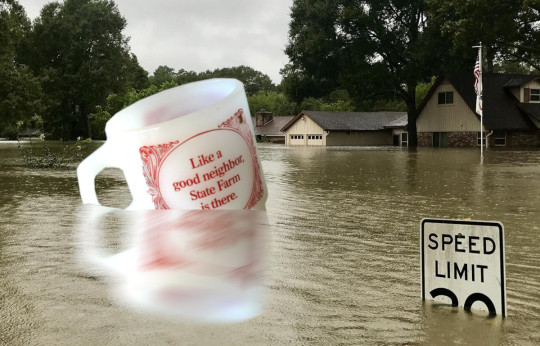
Tomorrow (November 29), I'm at NYC's Strand Books with my novel The Lost Cause, a solarpunk tale of hope and danger that Rebecca Solnit called "completely delightful."

Conservatives may deride the "reality-based community" as a drag on progress and commercial expansion, but even the most noxious pump-and-dump capitalism is supposed to remain tethered to reality by two unbreakable fetters: auditing and insurance:
https://en.wikipedia.org/wiki/Reality-based_community
No matter how much you value profit over ethics or human thriving, you still need honest books – even if you never show those books to the taxman or the marks. Even an outright scammer needs to know what's coming in and what's going out so they don't get caught in a liquidity trap (that is, "broke"), or overleveraged ("broke," again) exposed to market changes (you guessed it: "broke").
Unfortunately for capitalism, auditing is on its deathbed. The market is sewn up by the wildly corrupt and conflicted Big Four accounting firms that are the very definition of too big to fail/too big to jail. They keep cooking books on behalf of management to the detriment of investors. These double-entry fabrications conceal rot in giant, structurally important firms until they implode spectacularly and suddenly, leaving workers, suppliers, customers and investors in a state of utter higgeldy-piggeldy:
https://pluralistic.net/2022/11/29/great-andersens-ghost/#mene-mene-bezzle
In helping corporations defraud institutional investors, auditors are facilitating mass scale millionaire-on-billionaire violence, and while that may seem like the kind of fight where you're happy to see either party lose, there are inevitably a lot of noncombatants in the blast radius. Since the Enron collapse, the entire accounting sector has turned to quicksand, which is a big deal, given that it's what industrial capitalism's foundations are anchored to. There's a reason my last novel was a thriller about forensic accounting and Big Tech:
https://us.macmillan.com/books/9781250865847/red-team-blues
But accounting isn't the only bedrock that's been reduced to slurry here in capitalism's end-times. The insurance sector is meant to be an unshakably rational enterprise, imposing discipline on the rest of the economy. Sure, your company can do something stupid and reckless, but the insurance bill will be stonking, sufficient to consume the expected additional profits.
But the crash of 2008 made it clear that the largest insurance companies in the world were capable of the same wishful thinking, motivated reasoning, and short-termism that they were supposed to prevent in every other business. Without AIG – one of the largest insurers in the world – there would have been no Great Financial Crisis. The company knowingly underwrote hundreds of billions of dollars in junk bonds dressed up as AAA debt, and required a $180b bailout.
Still, many of us have nursed an ember of hope that the insurance sector would spur Big Finance and its pocket governments into taking the climate emergency seriously. When rising seas and wildfires and zoonotic plagues and famines and rolling refugee crises make cities, businesses, and homes uninsurable risks, then insurers will stop writing policies and the doom will become undeniable. Money talks, bullshit walks.
But while insurers have begun to withdraw from the most climate-endangered places (or crank up premiums), the net effect is to decrease climate resilience and increase risk, creating a "climate risk doom loop" that Advait Arun lays out brilliantly for Phenomenal World:
https://www.phenomenalworld.org/analysis/the-doom-loop/
Part of the problem is political: as people move into high-risk areas (flood-prone coastal cities, fire-threatened urban-wildlife interfaces), politicians are pulling out all the stops to keep insurers from disinvesting in these high-risk zones. They're loosening insurance regs, subsidizing policies, and imposing "disaster risk fees" on everyone in the region.
But the insurance companies themselves are simply not responding aggressively enough to the rising risk. Climate risk is correlated, after all: when everyone in a region is at flood risk, then everyone will be making a claim on the insurance company when the waters come. The insurance trick of spreading risk only works if the risks to everyone in that spread aren't correlated.
Perversely, insurance companies are heavily invested in fossil fuel companies, these being reliable money-spinners where an insurer can park and grow your premiums, on the assumption that most of the people in the risk pool won't file claims at the same time. But those same fossil-fuel assets produce the very correlated risk that could bring down the whole system.
The system is in trouble. US claims from "natural disasters" are topping $100b/year – up from $4.6b in 2000. Home insurance premiums are up (21%!), but it's not enough, especially in drowning Florida and Texas (which is also both roasting and freezing):
https://grist.org/economics/as-climate-risks-mount-the-insurance-safety-net-is-collapsing/
Insurers who put premiums up to cover this new risk run into a paradox: the higher premiums get, the more risk-tolerant customers get. When flood insurance is cheap, lots of homeowners will stump up for it and create a big, uncorrelated risk-pool. When premiums skyrocket, the only people who buy flood policies are homeowners who are dead certain their house is gonna get flooded out and soon. Now you have a risk pool consisting solely of highly correlated, high risk homes. The technical term for this in the insurance trade is: "bad."
But it gets worse: people who decide not to buy policies as prices go up may be doing their own "motivated reasoning" and "mispricing their risk." That is, they may decide, "If I can't afford to move, and I can't afford to sell my house because it's in a flood-zone, and I can't afford insurance, I guess that means I'm going to live here and be uninsured and hope for the best."
This is also bad. The amount of uninsured losses from US climate disaster "dwarfs" insured losses:
https://www.reuters.com/business/environment/hurricanes-floods-bring-120-billion-insurance-losses-2022-2023-01-09/
Here's the doom-loop in a nutshell:
As carbon emissions continue to accumulate, more people are put at risk of climate disaster, while the damages from those disasters intensifies. Vulnerability will drive disinvestment, which in turn exacerbates vulnerability.
Also: the browner and poorer you are, the worse you have it: you are impacted "first and worst":
https://www.climaterealityproject.org/frontline-fenceline-communities
As Arun writes, "Tinkering with insurance markets will not solve their real issues—we must patch the gaping holes in the financial system itself." We have to end the loop that sees the poorest places least insured, and the loss of insurance leading to abandonment by people with money and agency, which zeroes out the budget for climate remediation and resiliency where it is most needed.
The insurance sector is part of the finance industry, and it is disinvesting in climate-endagered places and instead doubling down on its bets on fossil fuels. We can't rely on the insurance sector to discipline other industries by generating "price signals" about the true underlying climate risk. And insurance doesn't just invest in fossil fuels – they're also a major buyer of municipal and state bonds, which means they're part of the "bond vigilante" investors whose decisions constrain the ability of cities to raise and spend money for climate remediation.
When American cities, territories and regions can't float bonds, they historically get taken over and handed to an unelected "control board" who represents distant creditors, not citizens. This is especially true when the people who live in those places are Black or brown – think Puerto Rico or Detroit or Flint. These control board administrators make creditors whole by tearing the people apart.
This is the real doom loop: insurers pull out of poor places threatened by climate disasters. They invest in the fossil fuels that worsen those disasters. They join with bond vigilantes to force disinvestment from infrastructure maintenance and resiliency in those places. Then, the next climate disaster creates more uninsured losses. Lather, rinse, repeat.
Finance and insurance are betting heavily on climate risk modeling – not to avert this crisis, but to ensure that their finances remain intact though it. What's more, it won't work. As climate effects get bigger, they get less predictable – and harder to avoid. The point of insurance is spreading risk, not reducing it. We shouldn't and can't rely on insurance creating price-signals to reduce our climate risk.
But the climate doom-loop can be put in reverse – not by market spending, but by public spending. As Arun writes, we need to create "a global investment architecture that is safe for spending":
https://tanjasail.wordpress.com/2023/10/06/a-world-safe-for-spending/
Public investment in emissions reduction and resiliency can offset climate risk, by reducing future global warming and by making places better prepared to endure the weather and other events that are locked in by past emissions. A just transition will "loosen liquidity constraints on investment in communities made vulnerable by the financial system."
Austerity is a bad investment strategy. Failure to maintain and improve infrastructure doesn't just shift costs into the future, it increases those costs far in excess of any rational discount based on the time value of money. Public institutions should discipline markets, not the other way around. Don't give Wall Street a veto over our climate spending. A National Investment Authority could subordinate markets to human thriving:
https://democracyjournal.org/arguments/industrial-policy-requires-public-not-just-private-equity/
Insurance need not be pitted against human survival. Saving the cities and regions whose bonds are held by insurance companies is good for those companies: "Breaking the climate risk doom loop is the best disaster insurance policy money can buy."
I found Arun's work to be especially bracing because of the book I'm touring now, The Lost Cause, a solarpunk novel set in a world in which vast public investment is being made to address the climate emergency that is everywhere and all at once:
https://us.macmillan.com/books/9781250865939/the-lost-cause
There is something profoundly hopeful about the belief that we can do something about these foreseeable disasters – rather than remaining frozen in place until the disaster is upon us and it's too late. As Rebecca Solnit says, inhabiting this place in your imagination is "Completely delightful. Neither utopian nor dystopian, it portrays life in SoCal in a future woven from our successes (Green New Deal!), failures (climate chaos anyway), and unresolved conflicts (old MAGA dudes). I loved it."

If you'd like an essay-formatted version of this post to read or share, here's a link to it on pluralistic.net, my surveillance-free, ad-free, tracker-free blog:
https://pluralistic.net/2023/11/28/re-re-reinsurance/#useless-price-signals
#pluralistic#doom loop#insurance#insuretech#climate#climate risk#climate emergency#the lost cause#market forces#risk management#price signals#control boards#decarbonization#bond vigilantes#climate resilience
262 notes
·
View notes
Text
Happy National Zookeeper Week!
I’ll admit, I’m feeling a little spicy about it this year (well, every year) because zoos use the celebration for lots of positive facility PR, yet staff don’t often get the support and respect that is claimed in those posts.
So I want to share this great article written by a zoo industry consulting group last year looking at the reality of what happens when a workforce ends up conflicted between their passion (zoos and animals) and pragmatism (paying rent, existing in a capitalist society). They assessed AZA compensation rates by region against things such as a living wage and rental rates in the area. (All text formatting within quotes, such as bold and italics, is original to the article text.)
I cannot give the Canopy Group enough support for the way they framed this research:
“By observing the economics of keeper compensation, it’s no secret that keepers land on the lower end of the wage spectrum. Like all other wages and salaries, the market value of keeper compensation is driven by several economic factors – including the size of the labor pool, the rigor and danger of the work, the technical ability required, and the educational requirements. However, there is one factor that artificially lowers the market value of keeper compensation more than any other: passion.
In this article, we’ll take a look at why passion lowers the market value of animal care worker wages. More importantly, we’ll consider many factors that have emerged in recent years that are making people reevaluate the value of following their passion – a trend contributing to The Great Resignation, especially as it applies to zoos, aquariums, and similar organizations. (…)
The argument here is passion versus pragmatism: the unknown versus the sure thing. It is a decision all zookeepers and animal care technicians have made. Working with animals is immensely rewarding, but this passion is also very popular. This, historically, has meant that the keeper candidate pool is very large. Therefore, if the wage is livable and working conditions are reasonable, the pool should remain large. In a very real sense, a passion for animals drives down the market value of keeper compensation. Anyone who has been through an Economics 101 course will recognize this as a fundamental market principle: supply vs. demand.
However, many zoos and aquariums are having a more difficult time filling positions than normal and have started to see higher turnover rates in recent years. This begs the question – is the current keeper wage too low?”
Their findings?
Here’s their graph of “the median wage of keepers from organizations in different AZA-defined regions” from an AZA survey done in 2021. (Median is the type of average that looks at the middle of a data set’s range).
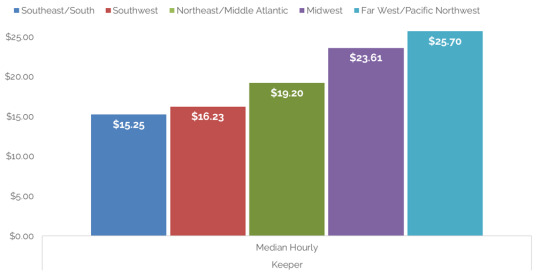
The median wage for AZA keepers in the South/Southeast was just over $15/hr at the low end, and the median wage for AZA keepers in the Far West / PNW was a little under $26/hr. That’s pretty dang low everywhere, especially when you factor in the increased cost of living in places like the West Coast. Also consider that looking at the median wage doesn’t mean this reflects just entry-level compensation - this data indicates the the compensation middle for all keeper positions, including people who have built their careers as keepers in those places long-term.
Then, they compared those wages to the “living wage” in each region - which they defined as “a calculation of what it takes to live in a particular area, without any other income. A living wage calculation takes into consideration how many earners are in a household, how many children are being supported, etc. The living wage includes the costs of all the basic items a household needs to be self-sufficient.”
“If you receive a wage for a job that is below the living wage, then you are essentially taking a negative net income. This is unsustainable for the long term, and essentially defines where wages start to exploit passion.”
Here’s a figure they provided using the MIT Living Wage Calculator showing the average living wage for each of the AZA regions. The chart on the left shows the living wage for a single person with no kids; the second, for two parents with two incomes and one child to support.
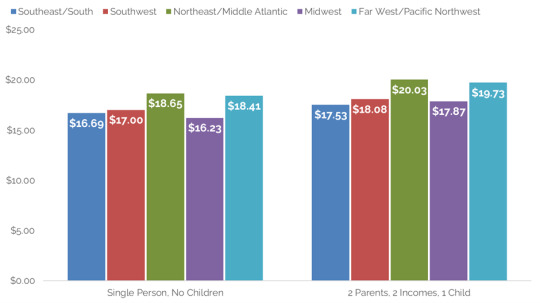
“By comparing the two graphs [to the earlier graph of the AZA median compensation rates], we find that median wages in the Southeast/South and Southwest regions are lower than the living wage for each household configuration in those regions. In other words, if you are a single person household or part of a two-income household raising 1 child in the South, a starting keeper salary will likely leave you with a negative net income. While many people work at this level, it increases the risk of accumulating debt, lowers a person’s ability to afford a home, set a much later retirement age, and can lead to many other negative, long-term effects.”
Big yikes, right?
Next, they looked at living wage vs. compensation for single parents.

“The single-parent living wage exceeds the average keeper wage in all AZA regions. In fact, the living wage required as a single parent is double the average AZA keeper wage in some regions.”
And then they did housing, specifically, being able to purchase a home.
“In many places, even a two-income household at an average keeper salary would not purchase a mid-level home. This means that keepers have to wait far longer than their peers to purchase a home. While paying rent in the meantime, this rent will account for a larger portion of their income than their peers. All in, these effects can set hopeful homeowners back years or decades.”
Canopy’s conclusion was something anyone involved in the field knew was coming.
“Companies like Chipotle, McDonalds, Best Buy, FedEx, Home Depot, Publix, and Walmart are all offering similar starting wages near starting keeper wages – plus many fringe benefits (like tuition reimbursement) and ample advancement opportunities. Many potential keepers in younger generations are putting their passion on the shelf so they can meet basic standard-of-living concerns.
To attract and retain quality candidates, an organization must consider the journey each new employee would have to make over their career. If the journey is fraught with massive debt, decreased disposable income, and limited career opportunities, then you are limiting your potential candidate pool to the small group of people who have decided that following their passion is worth significant lifelong financial hardship. There are many potential candidates out there willing to sacrifice and arm and leg for animals and conservation, but they wouldn’t dare jeopardize the financial future of their dependents and families.”
This is something I’ve heard about for years, and seen first hand. The low average wage at zoological facilities has been damaging their ability to hire and retain skilled staff for as long as I’ve been involved in the industry. I know so many zookeepers who still have roommates into their 30’s, or work multiple jobs, just to be able to make ends meet.
There’s a mythology about zookeeping jobs, a narrative that seeps into the field and actively exploits people’s passion for the job: it tells people that they’re so lucky to be able to work with these rare and cool animals; that they’re greedy and ungrateful when they ask for more compensation because they’re privileged to get to have the job at all. It says that most people would give anything to have these opportunities, so current zookeepers are interchangable and easily replaceable. Ask for too much? Push for a living wage? There’s always someone willing to take your spot. Not all facilities perpetuate this mentality - some places do treat their staff well without intentionally manipulating them to stay them in unsustainable jobs, and there can be legitimate financial reasons that limit staff compensation (mostly at smaller facilities, afaik) - but it’s a reality in the field.
For a long time, this type of mentality towards staff was sustainable. There really were always more people wanting to work in the field. But now, after three years of pandemic stressors and inflation, it’s starting to be a problem. A lot of staff left during the last few years, and facilities are having a really hard time hiring people and retaining them for any duration. I think a large part of that is low compensation rates. People are prioritizing long-term financial stability and recognizing when their passion is being exploited.
When I first started on tumblr back in 2011, there was a whole group of us within the United States who were baby zookeepers or volunteering as industry hopefuls. We all became friends, and I’ve stayed in touch with, or at least aware of, most of them as their careers progressed. Of the 10-15 or so people in that cohort? I can think of three who are still employed in the zoo industry. Everyone else has moved on into other fields - often with great grief over the loss - because of the extreme emotional labor, the physical exhaustion, and the lack of appropriate compensation.
But I guess that annual pizza party, being featured on social media, and maybe getting additional snacks all week makes up for it all?
#national zookeeper week#zoo industry#living wage#compensation#please support your local zookeeper#AZA accreditation#AZA zoos#zoos
552 notes
·
View notes
Note
real actual nonhostile question with a preamble: i think a lot of artists consider NN-generated images as an existential threat to their ability to use art as a tool to survive under capitalism, and it's frequently kind of disheartening to think about what this is going to do to artists who rely on commissions / freelance storyboarding / etc. i don't really care whether or not nn-generated images are "true art" because like, that's not really important or worth pursuing as a philosophical question, but i also don't understand how (under capitalism) the rise of it is anything except a bleak portent for the future of artists
thanks for asking! i feel like it's good addressing the idea of the existential threat, the fears and feelings that artists have as to being replaced are real, but personally i am cynical as to the extent that people make it out to be a threat. and also i wanna say my piece in defense of discussions about art and meaning.
the threat of automation, and implementation of technologies that make certain jobs obsolete is not something new at all in labor history and in art labor history. industrial printing, stock photography, art assets, cgi, digital art programs, etc, are all technologies that have cut down on the number of art jobs that weren't something you could cut corners and labor off at one point. so why do neural networks feel like more of a threat? one thing is that they do what the metaphorical "make an image" button that has been used countless times in arguments on digital art programs does, so if the fake button that was made up to win an argument on the validity of digital art exists, then what will become of digital art? so people panic.
but i think that we need to be realistic as to what neural net image generation does. no matter how insanely huge the data pool they pull from is, the medium is, in the simplest terms, limited as to the arrangement of pixels that are statistically likely to be together given certain keywords, and we only recognize the output as symbols because of pattern recognition. a neural net doesn't know about gestalt, visual appeal, continuity, form, composition, etc. there are whole areas of the art industry that ai art serves especially badly, like sequential arts, scientific illustration, drafting, graphic design, etc. and regardless, neural nets are tools. they need human oversight to work, and to deal with the products generated. and because of the medium's limitations and inherent jankiness, it's less work to hire a human professional to just do a full job than to try and wrangle a neural net.
as to the areas of the art industry that are at risk of losing job opportunities to ai like freelance illustration and concept art, they are seen as replaceable to an industry that already overworks, underpays, and treats them as disposable. with or without ai, artists work in precarized conditions without protections of organized labor, even moreso in case of freelancers. the fault is not of ai in itself, but in how it's yielded as a tool by capital to threaten workers. the current entertainment industry strikes are in part because of this, and if the new wga contract says anything, it's that a favorable outcome is possible. pressure capital to let go of the tools and question everyone who proposes increased copyright enforcement as the solution. intellectual property serves capital and not the working artist.
however, automation and ai implementation is not unique to the art industry. service jobs, manufacturing workers and many others are also at risk at losing out jobs to further automation due to capital's interest in maximizing profits at the cost of human lives, but you don't see as much online outrage because they are seen as unskilled and uncreative. the artist is seen as having a prestige position in society, if creativity is what makes us human, the artist symbolizes this belief - so if automation comes for the artist then people feel like all is lost. but art is an industry like any other and artists are not of more intrinsic value than any manual laborer. the prestige position of artist also makes artists act against class interest by cooperating with corporations and promoting ip law (which is a bad thing. take the shitshow of the music industry for example), and artists feel owed upward social mobility for the perceived merits of creativity and artistic genius.
as an artist and a marxist i say we need to exercise thinking about art, meaning and the role of the artist. the average prompt writer churning out big titty thomas kinkade paintings posting on twitter on how human made art will become obsolete doesnt know how to think about art. art isn't about making pretty pictures, but is about communication. the average fanartist underselling their work doesn't know that either. discussions on art and meaning may look circular and frustrating if you come in bad faith, but it's what exercises critical thinking and nuance.
207 notes
·
View notes
Text
Articles, reports, and studies about agriculture are likely to contain some version of the following sentiment: “The population is expected to grow to almost 10 billion people by 2050. We must double food production in order to meet demand without hiking up prices. How are we going to produce enough food to feed all of these people without destroying the planet?”
Increasing food production to meet the demands of a growing population is presented as the ultimate conundrum. Proposed solutions are predominantly centered on increased reliance on technologies to maximize yields and feed ‘all of these hungry people’ as the population grows, accelerating at a seemingly unstoppable rate. Whatever new technologies or techniques are introduced, they are, first and foremost, measured along the metric of increasing yield.
This narrative isn’t just misguided — it depoliticizes the problem, shifting blame in a dangerous way.
The reality is that we have enough food on the planet to feed every human being a calorically complete and healthy diet. Contrary to popular belief, hunger is most often caused not by a lack of food but by a lack of access. With the amount of food we produce today, we could feed the highest population prediction of 10 billion people by 2050 — today.
This has much more to do with economic inequality than anything to do with population. The people who cannot afford food are most often the people involved in growing it. The vast majority of the world’s impoverished people, most of whom live in rural areas, are involved in agriculture. This seems counterintuitive, but many farmers worldwide are net food buyers, meaning they do not subsist on the food they grow, they sell their crops and use that money to buy food for their families.
When prices for crops are too low to offset input prices, when farmers face barriers to accessing markets or credit, or they are forced into exploitative contracts or other arrangements, farmers do not have adequate funds to purchase food for themselves and their families. This is the result of the long process of industrialization that has displaced millions of rural people and removed them from their traditional agricultural practices, replacing polycultures with monocultures.
Perhaps the other most damning piece of evidence to counter the narrative that we must ramp up production to end hunger is that some cities have already ended it — without increasing yield. Belo Horizonte, one of the largest cities in Brazil, managed to virtually eliminate hunger through a network of policies addressing different facets of the issue. They expanded school meal programs; partnered with local small farmers to deliver produce to underserved parts of the city at fixed prices for staples; created subsidized restaurants where people could eat affordable, dignified meals, and a host of other policies. It never took more than 2 percent of their annual budget, and the whole transition took less than 10 years. It didn’t require corporations ‘innovating’ or developing expensive technologies. It required political will, the strengthening of governance systems, declaring food as a right of citizenship, and correcting for hunger as a market failure.
We are choosing not to end hunger. Presenting it otherwise obscures the fact that it is, at its core, a matter of political will — not a matter of ability.
198 notes
·
View notes
Text
A Cascading Fix
The floating garbage patch in the Pacific Ocean a huge ongoing issue. Plastic is the worst offender (and no it’s not all drinking straws and plastic bags— it’s mostly discarded fishing nets). Skimming would be too costly and unrealistic (it’s country sized— big country). Plus is almost a biome at this point— you couldn’t scoop out the trash without also scooping animals/eggs/plants basically causing more havoc trying to clean it up.
So what do you turn to? Bacteria
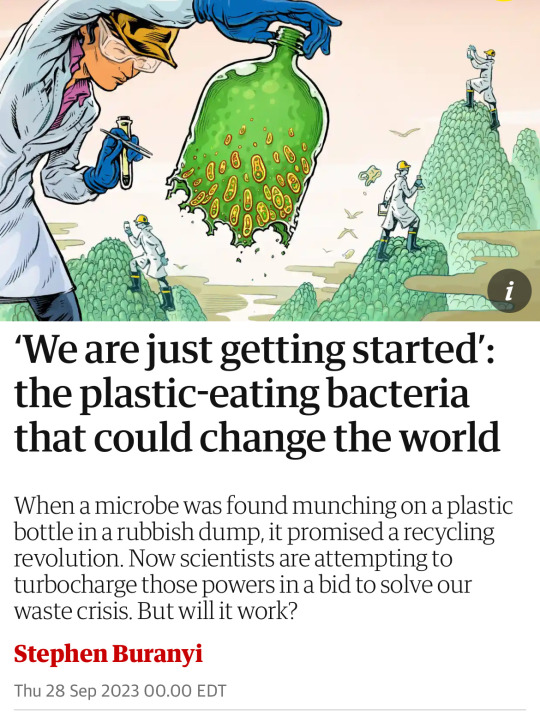

So this area has been in active research for 25+ years as the ultimate solution to dealing with plastic waste.

Should be great right? The lifespan of a bottle in a landfill falls from centuries to weeks in a vat. It’s such an alluring goal that people gloss over the path
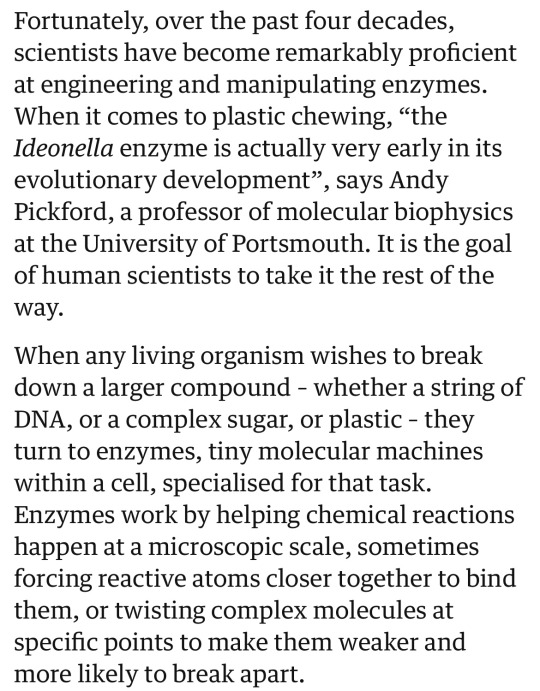

Brute forcing thousands upon thousands of mutations on an enzyme that specializes in breaking down hydrocarbons sounds wildly risky.
Because what if you get one that does too well?
Future Forecaste
Silicon Valley Tech Bro Billion wants to try and improve his image as a part of the private jet class by holding a big public competition for innovative solutions for the garbage patch. Encourages all of his tech bro buddies to pitch their ideas. Billionaire promises to fund a pilot project for the top idea.
What wins out? Bacteria
And they apply the Facebook ‘move fast and break things’ philosophy to brute forcing mutations. Garbage patch is in international waters, so no approval (or oversight) to go and test your ideas.
In fact, with being out in the middle of the ocean, you can build your lab right on a boat and sail out there. And test your iterations right there. In the ocean. Why test on a simulated garbage patch when the real one is right there?
Success! A strain that breaks down plastics in a short timeframe in the cold of the ocean! Your test site quickly goes from floating landfill to. something?
The enzymes broke the plastic into component nutrients. So you now have effectively dumped a whole flood of nutrients into the water. Kinda like dumping fertilizer

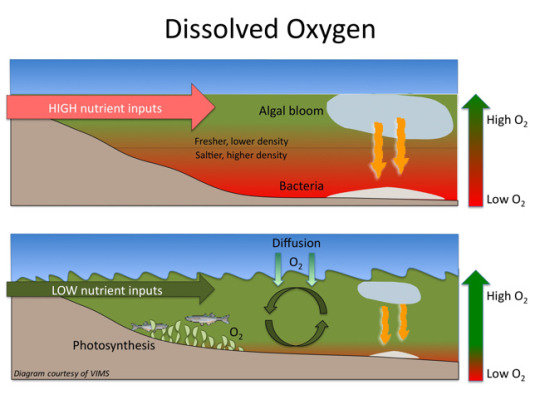
Cool. So now you you have turned garbage patch into the Great Pacific Algal Bloom and Dead Zone
And the bacteria isn’t staying put. Oceans have a way of moving things, and you just built a hardy sailor with a plentiful food supply.
The bacteria makes it to shore and suddenly, plastic isn’t permanent. Plastic isn’t safe in water. Every seal and gasket is now prone to failure. There is a rush to figure out which types of plastics are susceptible, which are resistant. New plastics with bacteria resistance are developed.
But that’s not even going to be the biggest issue
We’ve Got a Fuel Pox on our Hands
If it likes to eat plastic know what it’ll love? Gasoline and any other hydrocarbon
This bacteria would essentially turn gas into soy sauce. Think about fuel rotting
Suddenly world’s energy supply is at risk. Fear of contamination becomes the oil and gas industry’s number one concern. Gas becomes an even more precious commodity, and is only used when application demands. The industry takes on surgical level of cleanliness.
Meanwhile other people are prepping ‘Kombucha’ for their local pipeline
56 notes
·
View notes
Text


Thanks to Ingek73 for sending this 1873 school that was converted to residential use in the 1990’s in London, UK. Some original features such as staircases, roof structure and fireplaces have survived. 4bds, 3ba, £1,450,000 / $1.837M + £11,520 / $14,597 yearly service fee.
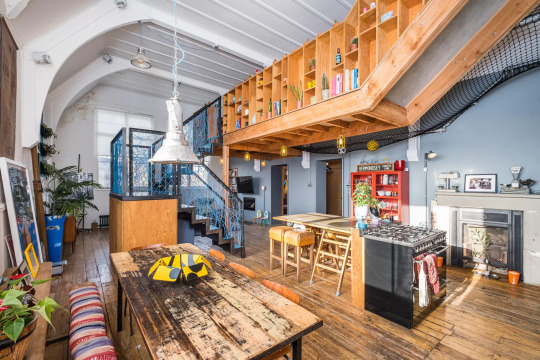
This is a different style from the one we saw yesterday. This one is more rustic/industrial and, of course, more colorful.
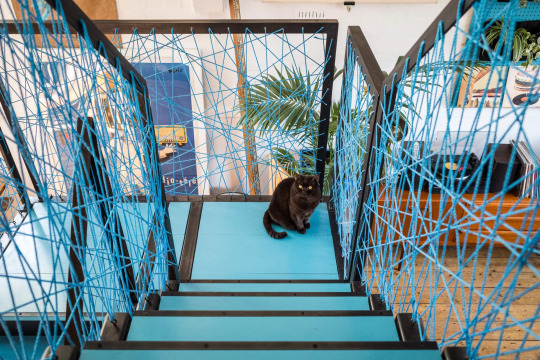
Look at the interesting railings. I'm surprised that the cat doesn't climb that.

Comfortable, casual living room area.

It has a modern fireplace built into the wall.

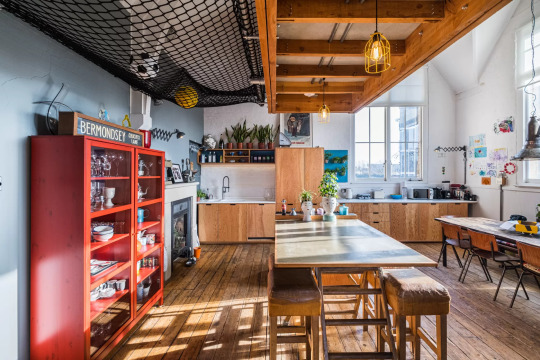
What a nice kitchen. Now, I can't decide which one I like better.
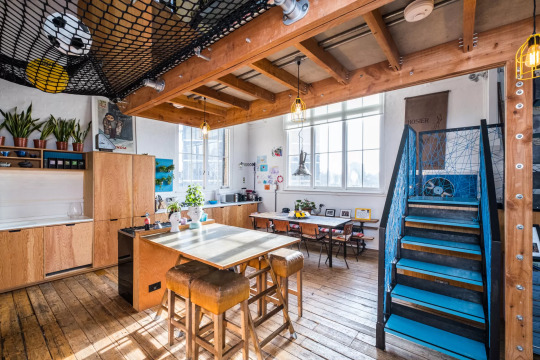
There's a smaller dining table in the kitchen, as well as one that seats 8.

That's nice, a fireplace in the kitchen.

What a cool bathroom. Very modern industrial.

Look at the shelving in the railing.


There's this net thing for the kids to play in.

Quite a lot of options regarding levels.

Nice small den has its own bathroom.
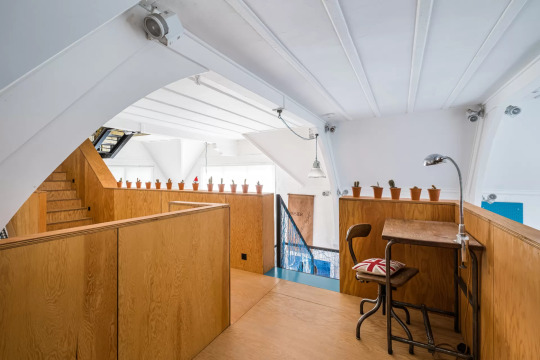
And a small desk in the corner of the mezzanine.


This is a large apt. b/c it has 4 bedrooms. The primary is nice and big. It overlooks the first floor and also features a window.

Very industrial cement and brick bath.

Sizable room for a nursery.

I wouldn't want to make this a children's room. Not with that gorgeous fireplace.


This is nice. The other apt. we saw didn't have any outdoor space. I think if I had to choose between the 2, it would be this one, even though I would buy the other one b/c of the sophisticated, smaller look size. I don't need this much space.

76 notes
·
View notes
Text
The perfect storm had been building for some time. Ferguson is at the bottom of the income spectrum and has acted as a sort of vanguard for the outward march of suburban poverty. [...] [T]he dwindling population, fleeing industry, and plummeting property values had created a budgetary crisis, forcing many of the area’s small municipalities to rely less on their shrinking tax base and more on extra-tax fees and fines, enforced by the police and facilitated by the city’s arcane court system.
The result was that Ferguson and similar suburbs existed in what the Huffington Post called “a totalizing police regime beyond any of Kafka’s ghastliest nightmares.” Out of a population of roughly 21,000, over 16,000 Ferguson residents had arrest warrants issued. And this number only counts individuals with warrants, not the total number of warrants. In 2013 this figure was a staggering 35,975, roughly 1.5 warrants per person in the city.
These warrants were part of a complex racket designed to impose unrelenting fines on the poor population in order to fund the city government, which itself had largely been redesigned to facilitate this predatory practice.
In 2013 fines, court fees, and other such extortions accounted for some 20 percent of the city’s budget. These fines were disproportionately applied to the city’s black residents, with black drivers twice as likely to be stopped, searched, and arrested as their white counterparts. [...]
---
These funding systems are not unique to St Louis, but instead became a national trend as more and more municipalities found themselves in dire conditions after the last crisis. The suburbanization of poverty and skyrocketing incarceration rates have thus been paired with growth in these massive, extra-tax extortions applied to the poor -- and particularly the suburban and rural poor, who are more likely to live in small, cash-strapped municipalities (or counties) with a dwindling tax base and less access to federal aid. In most places, this takes the form of an expanding net of legal search, supervision, and harassment that essentially extends the walls of the prison out into the new suburban ghetto.
Increasingly expensive incarceration is gradually replaced by a predatory probation system composed of extra-carceral monitoring, fines, and seizure of property, all amplified by the fusion of public budgets and for-profit probation companies.
Many of these are relatively recent trends, with Ferguson’s dependence on probation funding skyrocketing after 2010. But rather than an unfortunate exception, Ferguson is a window into the future. As low growth, deepening crisis, and general austerity continue [...] [t]hese cities will be forced to find new sources of funding, and the easiest way to do this is for better-off residents to utilize existing legal resources in order to prey on the poor.
As the economic situation becomes increasingly dire, similar patterns emerge at greater scales: the county, the state, and the federal government will all turn to such predatory practices, facilitated by growing armies of police and preexisting legal mechanisms for debt collection, surveillance, and incarceration.
---
These patterns are piloted in the poorest areas, applied first to the most disadvantaged social groups. In Anaheim, California, the poorer, predominantly Latino neighborhoods in the city have seen a series of gang injunctions, allowing plainclothes police to arrest and open fire on residents for things as simple as their clothing color or gathering in a crowd. In 2012 a sequence of police shootings in the city led to nights of rioting just outside D!sneyl@nd. In the poorer parts of New York, stop and frisk policies and the enforcement of laws against minor offences (such as selling loose cigarettes) have allowed for similar practices, resulting in local riots around the killing of Kimani Gray in Flatbush in 2013 and national riots around the killing of Eric Garner in 2014. Similar practices have long been applied to the rural poor, including the black residents of regions such as the Mississippi River Delta, Native residents of reservations such as Pine Ridge, Latino farmworkers across the country, and the white poor in places like the coal-mining towns of Appalachia.
-------
Text by: Phil Neel. Hinterland: America’s New Landscape of Class and Conflict. 2018. [Bold emphasis and some paragraph breaks/contractions added by me.]
1K notes
·
View notes
Text
"When Francois Beyers first pitched the concept of 3D ocean farming to the Welsh regulators, he had to sketch it on napkins.
Today the seafood farm is much more than a drawing, but if you walked along the Welsh coastal path near St David’s, all you’d see is a line of buoys. As Beyers puts it: “It’s what’s below that’s important.”
Thick tussles of lustrous seaweed suspend from the buoys, mussels cling to its furry connective ropes and dangling Chinese lantern-esque nets are filled with oysters and scallops.
“It’s like an underwater garden,” says Beyers, co-founder of the community-owned regenerative ocean farm, Câr-y-Môr. The 3-hectare site is part of a fledgling sector, one of 12 farms in the UK, which key players believe could boost ocean biodiversity, produce sustainable agricultural fertiliser and provide year-round employment in areas that have traditionally been dependent on tourism.
Created in 2020 by Beyers and six family members, including his father-in-law – an ex-shellfish farmer – the motivation is apparent in the name, which is Welsh for “for the love of the sea”. ...
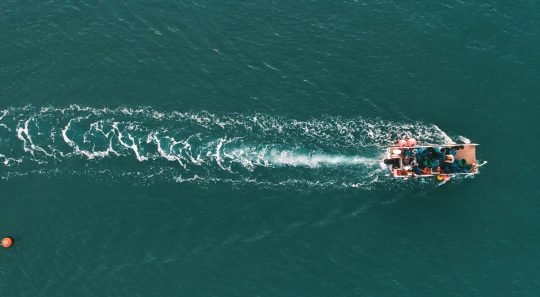
Pictured: Drone shot of Câr-y-Môr, which is on the site of abandoned mussel farms. Image: Scott Chalmers
Ocean farming comes from the technical term ‘integrated multi-trophic aquaculture’, which means a mixture of different seaweed and shellfish species growing together to mutually benefit each other. But it’s not just a way of growing food with little human input, it also creates ocean habitat.
“You’re creating a breeding ground for marine animals,” explains Beyers who adds that the site has seen more gannets diving, porpoises and seals – to name a few – since before the farm was established.
Ocean farms like Câr-y-Môr, notes Ross Brown – environmental research fellow at the University of Exeter – have substantial conservation benefits.
“Setting up a seaweed farm creates an exclusion zone so fishermen can’t trawl it,” explains Brown, who has been conducting experiments on the impacts of seaweed and shellfish farms across the UK.
Brown believes a thriving ocean farming industry could provide solutions to the UK’s fish stock, which is in “a deeply troubling state” according to a report that found half of the key populations to be overfished. “It would create stepping stones where we have safe havens for fish and other organisms,” he adds.
But UK regulators have adopted a cautious approach, note Brown and Beyers, making it difficult for businesses like Câr-y-Môr to obtain licenses. “It’s been a tough old slog,” says Beyers, whose aim is to change the legislation to make it easier for others to start ocean farms.
Despite navigating uncharted territories, the business now has 14 full-time employees, and 300 community members, of which nearly 100 have invested in the community-benefit society. For member and funding manager Tracey Gilbert-Falconer, the model brings expertise but most importantly, buy-in from the tight-knit local community.
“You need to work with the community than forcing yourself in,” she observes.
And Câr-y-Môr is poised to double its workforce in 2024 thanks to a Defra grant of £1.1 million to promote and develop the Welsh seafood industry as part of the UK Seafood Fund Infrastructure Scheme. This will go towards building a processing hub, set to be operational in April, to produce agricultural fertiliser from seaweed.
Full of mineral nutrients and phosphorous from the ocean, seaweed use in farming is nothing new, as Gilbert-Falconer notes: “Farmers in Pembrokeshire talk about their grandad going down to the sea and throwing [seaweed] on their farms.”
But as the war in Ukraine has caused the price of chemical fertiliser to soar, and the sector tries to reduce its environmental impact – of which synthetic fertiliser contributes 5% of total UK emissions – farmers and government are increasingly looking to seaweed.
The new hub will have capacity to make 65,000 litres of sustainable fertiliser annually with the potential to cover 13,000 acres of farmland.
But to feed the processing hub, generate profit and reduce their dependency on grants, the co-op needs to increase the ocean farm size from three to 13 hectares. If they obtain licences, Beyers says they should break even in 18 months.
For now, Beyers reflects on a “humbling” three years but revels in the potential uses of seaweed, from construction material to clothing.
“I haven’t seen the limit yet,” he smiles."
-via Positive.News, February 19, 2024
#wales#welsh#ocean#marine biology#aquaculture#marine life#marine animals#seaweed#sea scallops#oysters#united kingdom#uk#conservation#conservation news#overfishing#environmental news#farming#sustainable agriculture#sustainability#ocean farming#good news#hope
462 notes
·
View notes
Text
Every family wants to stay safe and protect their family members from getting involved in an accident while they are on the balcony. Aaradhay Safety Nets offers you top- The Best Experienced and Expertise Safety Nets providers since Sixteen Years...
#children safety nets#terrace top safety nets#staircase safety nets#monkey safety nets#animal nets#coconut tree safety nets#industrial safety nets#construction safety nets#swimming pool safety nets#glass safety nets#car parking safety nets#parking nets#building safety nets#duct area safety nets#hdpe nets and nylon nets#pigeon safety nets#pigeon nets installation#bird spikes#bird protection nets#anti bird nets#pigeon nets for balcony#cricket nets#all sports nets#sports nets near me#football and volleyball nets#nursery shade nets#installation of nets#all safety nets#terrace nets#bird nets
0 notes
Text
So many of our loved ones have left us recently. I speak, of course, of restaurants. Times are tough for the food-providing industry, between landlords turning the screws on innocent business owners, workers asking for a liveable wage, the price of wilted iceberg lettuce, and the incessant hum that directs, nay, commands them to sleepwalk in the middle of the night towards the howling void that lives at the centre of town. With all this in mind, it should be no surprise that our favourite greasy spoons are at risk of closure.
Everyone agrees that the real victim in all this is me. Restaurants that are closed sit useless and empty, unable to be converted into garages because of bigoted anti-shitbox municipal building code. I can't even park in front of them for a long period of time, because the city fathers decided to put parking meters in front of them back when they were popular restaurants. No matter how you look at this, there is simply no way I can benefit from the current state of affairs, which is the biggest tragedy of all.
There is one hole in their logic, though. Food trucks. Because of a little mix-up in the city's health code – a teeny-tiny boo-boo – food trucks can be run as long as you have the rights to a former restaurant. And, despite the name, there is actually no legal requirement as to what kind of vehicle a food "truck" is. See where I'm going with this? I hope you do, because otherwise it's going to be very awkward when a smoking 1978 Volare is parked outside your house, pouring boiling 75W90 engine oil into the gutter from its near-shattered slant six. It will still have a net benefit, thanks to the fact that I've ratchet-strapped an old Frito-Lay snack vending machine to the backside. Try the Fritos, or the Lays, and either way you can't deny that it's a motor vehicle you can buy food from.
All this is really a roundabout way to say that I've bought the rights to several dozen bankrupt restaurants, cafes, eateries, and saloons dotted about the tri-state area. To tow me – to dare to oppose my might – is to challenge the primacy of small-business food service the world over. It's gonna bring some heat. And let me tell you, if you think you have a problem now, with some weirdo dispensing potato chips into your neighbourhood? Wait until Ikea shows up with one of a fleet of specially-modified Volvo 240s, machine-gunning free samples of Swedish meatballs into anything that stands still long enough to show up in the sights.
134 notes
·
View notes
Text
Solarpunk by the sea

Let me continue this little series on Solarpunk in different kinds of biomes and let me talk about the one biome that probably has the most people living by it: The ocean.
The ocean is a weird thing for us. While we cannot survive in it, we thrive if we have it close by. We cannot consume the salt water, of course, but we were always drawn to the ocean and fish, of course, have for many civilization been one of the biggest sources of food. Most people on this planet currently live somewhat close to a coastline of some sort.
While civilization might have started in those dank river valleys, many of the big civilization at some point needed access to the ocean. For the fish, but also to further advance. As the ocean allowed to move a lot of stuff rather quickly.
But... currently we are not doing well with the ocean, do we? There is a reason the whales are rebelling and shit.
We are currently overfishing the ocean, with the garbage from industrial fishing (like fishing nets) being a large part of the macroplastic in the oceans.
Meanwhile, the ocean like everything else, is also filled with microplastics - a bit part of which come from wheel abrasions from cars and the like.
And, of course, with the ocean warming, it can no longer hold oxygen and basically fishes die of in mass.
So, let's talk about it. How do we live with the ocean? How do humans best thrive near the ocean? And how do we protect this biome?
First of all: Industrial fishing has to go. People catching their own fish are fine. Even like Joe and his family catching fish for their little local fishmonger is fine. But industrial fishing that catches fish for this big international company that makes sure that everyone - no matter how far away from the coast they are living - has fish in their freezer... Yeah, we cannot have that. Not only because we overfish certain species of fish and endanger the whales, but also because through this we completely mess with food chains and eco systems, because - for example - the fish shitting is actually kinda important for the ocean.
So, yeah. No big fishing. If you live not close by an ocean, you will not get any ocean fish. Sorry.
Now, people living close to the ocean obviously face one big challenge: The ocean will often bring some sort of storm in relatively regular intervals. I will not go into the reasons of this (if you wanna see me geek out over meteorology, just say - I can do that). But of course everyone knows about all those Hurricanes that will strike the coastlines every year.
Different human cultures have adjusted differently to this. Basically there are two ways to go about it: Either you just accept that your house will be destroyed and build it in a way, that it will be easy to rebuild... Or you try to build a house that will wistand most storms with only minor damage.
This could be done by using sturdy materials - or by doing the other thing: Put your house on stilts. Which can be surprisingly effective, which is why we see it around the world.
Ideally you will not build the houses directly at the edge of the water. While it is fancy, duh, it also removes the saving land between you and the ocean.
Which also brings me to the sponge biomes, that often get ignored too often. Modern civilization often has destroyed those sponge areas, that usually would help take the swell of a storm surge. Those areas need to be recultured. Both to save them as biomes, as well as helping keeping us save from the floods.
When it comes to energy and renewables... Well, great news. The coastlines give us an endless amount of possibilities. Off-shore wind turbines work great. We probably will have soon enough proper tidal turbines, too. Maybe we will even figure out wave energy. And yes, you can put up photovoltaic panels.
Humans fear the ocean. Humans cannot survive in the ocean. But at the same time, we love the ocean and it has helped us to survive for so long.

#solarpunk#solarpunk fiction#solarpunk worldbuilding#ocean#oceans#shoreline#sustainability#renewable energy#save the oceans#save the whales#fishing
56 notes
·
View notes
Text
The U.S. political right wing does not have an answer to climate change. Neither does the technocratic and centrist net-zero discourse, which has failed to achieve adequate reductions, as will become increasingly apparent within just a few years. With no one else driving the agenda, the left needs to offer an alternative, sector-by-sector roadmap for decarbonization. We need to fill the voids in leadership, analysis, planning, organizing, and coalition-building. Rather than focusing on particular technologies, we need to be setting objectives for the areas in which these technologies could be used. If we put forward both best-use cases for CCS and alternatives to CCS, we are more likely to avoid bad CCS projects—and we can play a leading role rather than a defensive one.
[...]
It’s true that we need a robust climate movement to block truly harmful projects that would lock in new fossil fuel infrastructure or violate Indigenous sovereignty, and it is critical to support communities in this work. But it would be a mistake to narrowly focus climate organizing on reenacting successful infrastructure-blocking tactics in ways that fail to discern useful industrial carbon projects from bad ones. Such an approach puts the climate movement into a reactive role just when climate advocates need to be the ones who plan the energy transition. Taking a wider-strategy approach to CCS will take patience. It will require building broader coalitions and organizing in rural areas where a lot of decarbonization needs to happen. It will be challenging—but the cost of being absorbed by the CCS distraction is not one that the movement can afford.
176 notes
·
View notes
Text
Korea Game awards Game Director interview transcription <Lies of P>
Source (KR)
Hey so, I went through some Korea Game Awards stuff. It looks like there was a lot of content recorded for the event, but it doesn't really seem available online. I did find this interview with the director uploaded by a ruliweb user. It ended up being more of talk related to the industry and not all that related to LoP, but I figured I might as well share it since and I had gone through it anyway [and who knows, this could all be lost media one day!].
On LOP winning GOTY - South Korea
The Metacritic score was honestly higher than he expected
Talk about expanding the console games industry in Korea. Again, in South Korea - a leading world of PC Bangs and E-Sports, MMORPGs reign supreme! [Reading around the k-net supposedly LoP is notably one of the first major south korean developed single-player console title? I want to write about this more]
Influenced by other console, single player titles like Naughty Dog's Uncharted Series. [me: I love you, NG's The Last of Us.]
I'm pretty sure that based on his answers he will continue to spearhead the Lies of P IP
Send me an Inbox if you have a correction or see possible error/clarification needed!
[The "footage" doesn't seem available so it's a little hard for me because we can't hear the phrasing, so it's my best guess]
[VERY ROUGH TRANS]
ENG
Hello, nice to meet you, I am Choi Ji-won, general director of Lies of P [Jiwon Choi]
What games have you participated in developing so far?
Asker Online, and just recently I was in charge of Lost Ark. [note: MMORPG and he did combat direction]
What do you think are the virtues of a good developer?
Above all, I think it's being clear and unwavering in direction
To what extent have I achieved compared to my goal?
I think I've achieved about 80% of it.
I think the remaining 20% area
I want to at least overcome that level of fun I had, and the remaining area is one where the goal is to explore new fun
To do that, you have to put in a lot of effort, enjoy the game a lot, and talk a lot with your fellow development colleagues to achieve the fun you want
I want to get into that zone
This is really honest
What advice can you give to juniors who want to become developers?
Above all, you must become a gamer
'Does that fun really move you?'
And do you want to give this feeling to yourself by becoming a developer?'
I would like to take this opportunity to tell you once again that it is more important than anything to make an effort just to have fun
Why did you become a game developer?
I've been a console game fanatic since I was young
So, while enjoying famous masterpieces in console games, I also want to create a game that can provide this kind of fun
I think it would be The Uncharted Series at that time
I think I was able to analyze why this was fun while playing
So I decided to become that kind of developer
What do you think about the Metascore rating results? [note: I'm assuming they're talking about the metacritic score, which is a critic aggregate (Lies of P currently sits at an 80)]
I'll be really honest about this too
I thought it was a better score than the score I received. [Note: This is what he says, but I think what he means is "It was a better score than the one what I was expecting"]
When I saw the evaluations of the metascore I realized
I was only thinking about a small aspect and thought, 'I was [too] focused on the completion of just this area'
But now, 'I need to think about a broader field and focus on it again.' It was that kind of experience
What is your ultimate goal as a developer?
Rather than being a developer who receives positive reviews from users, I actually want to remain as a developer who has a positive influence on other fellow developers in the field
I hope to become someone who can serve as an opportunity to further improve and develop the development culture and development capabilities of our country's game industry
How do you feel when you receive positive and negative feedback?
(If you think positively) Thank you
But I think we should never be satisfied with that
(When receiving negative feedback)
More and more, there were instances of reflection from a gamer's perspective like ‘Okay. I should have been more in his shoes.’
Any last words you would like to say?
I don't think this award is ever meant for me
I think this is an award given to everyone on the team
I will take this as a sign to work even harder in the future
We will continue to do our best to become a developer that can provide only fun and emotion
KOR
안녕하세요 반갑습니다 <> 총괄 디렉터 최지원 입니다
Q: 그동안 개발에 참여하신 게임은 ?
<애스커 온라인>, 직전엔 <로스트아크> 프로젝트를 담당했습니다
Q: 좋은 개발자의 덕목은 무엇이라고 생각하시나요?
무엇보다 뚜렷하고, 흔들리지 않는
방향성을 제시하는 것이라고 생각합니다
Q: 내 목표정에 비해 어는 정도까지 달성했나요?
약 80% 정도는 달성했다고 생각을 해요
남은 20% 영역
본인이 느꼈던 그 재미 이상을 넘어서
새로운 재미를 추구할 수 있는 영역이라고 생각을 합니다
그러려면 정말 노력도 많이 해야 되고
게임도 많이 즐겨야 되고
같은 개발 동료분들과도
원하는 재미를 정말 많이 한 방향이 되도록
대화도 많이 해야 되거든요
저는 그 영역에 도달하고 싶습니다
이게 정말 솔직한 겁니다
Q: 개발자가 되고 싶은 후배들에게 해줄 수 있는 조언은?
무엇보다 게이머가 되어야 됩니다
그 재미를 통해서 본인에게 정말 감동이 되는가?'
그리고 이 감동을 본인도 개발자가 돼서 선사하고 싶은가?'
진짜 재미만을 위해서 노력하는 게
무엇보다 중요하다는 것,
다시 한번 이 자리를 빌려서 말씀드리고 싶습니다
Q: 게임 개발자가된 계기?
저는 어렸을 적부터 콘솔 게임 덕후였습니다
그래서 콘솔 게임에서 유명한 명작들을 즐기면서
나도 꼭 이런 재미를 줄 수 있는 게임을 만들고 싶다
그때는 <언차티드 시리즈>일 것 같아요
플레이하면서 이게 왜 재밌는지를 분석을 할 수 있었던 것 같아요
그래서 그러한 개발자가 되기로 결심을 하게 됐습니다
Q: 메세타스코어 평점결과 에 대해서 어떻게 생각하시나요?
이것도 정말 솔직하게 얘기할게요
받은 점수보다는 더 나은 점수라고 생각을 했었어요
그 메타스코어에 대한 평가 내용들을 봤을 때는
납득이 가더라고요
작은 영역에서만 생각을 했었고
'그 부분에 대한 완성도만 봤었구나...'
근데 이제는 '더욱더 넓은 분야까지도 생각을 하고,
또 정진해야겠다.' 그러한 계기가 됐었습니다
Q: 궁극적인 개발자로서의 목표가 있다면?
유저들에게 좋은 호평을 받는 개발자이기보다는
현업에 있는 다른 동료 개발자들에게
긍정적인 영향을 미치는 개발자로 사실 남고 싶어요
우리나라 게임업계에 대한 개발 문화나
개발력이 더욱더 개선되고 발전하는
그러한 계기가 될 수 있는 사람이 되었으면 좋겠습니다
Q: 긍정적 & 부정적 피드백을 받을때의 기분은?
(긍정적으로 생각해주시면) 감사하죠
하지만 그것으로 만족해서는 절대 안 된다고
생각을 하고 있습니다
(부정적 피드백을 받으면) 더욱더 게이머 입장에서
'아차, 제가 더욱... 더 그분의 입장이 되어야 했었구나'라고
반성을 하는 경우도 많았었습니다
Q: 마지막으로 하고싶으신 말은?
이 상은 결코 저에게 주는 상이 아니라고 생각을 해요
팀 모든 분들에게 주어지는 상이라고 생각을 하고
앞으로도 더욱더 열심히 하라는 뜻으로 받아들이겠습니다
오직 재미와 감동만을 선사할 수 있는
그런 개발자가 되도록
계속 최선을 다하도록 노력하겠습니다
#man my korean is really not good#I am going through some LOP IRL stuff first! sorry for the wait for inbox answers.#I did come across some other interesting game-related stuff that I plan on sharing later#lies of p#liesofp#lop#lop irl#lop bts#jiwon choi#translation#korea game awards#full disclosure: i put it through google translate and then went through it manually a couple of times for error check/edits
12 notes
·
View notes